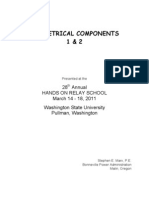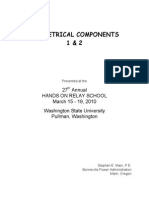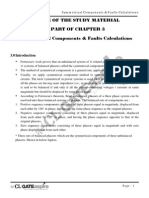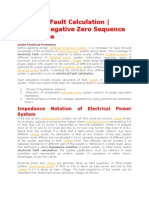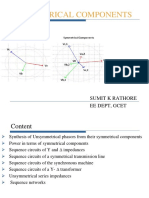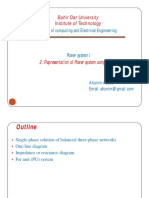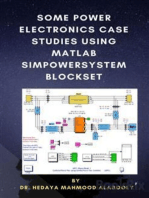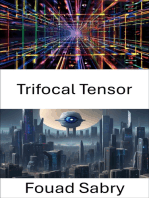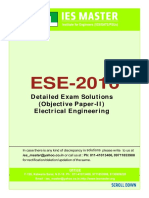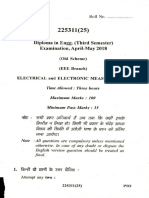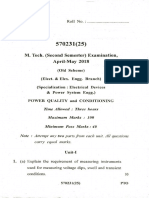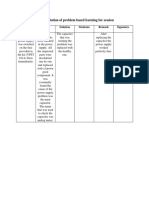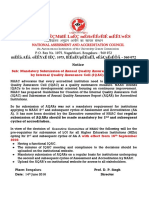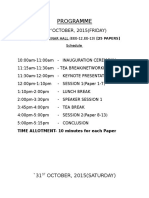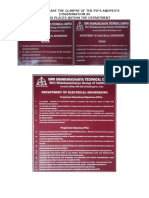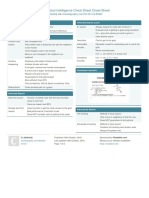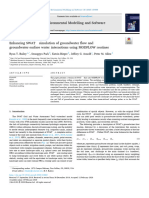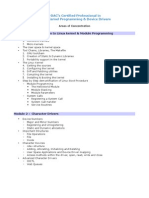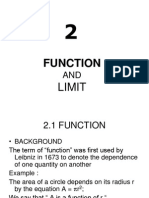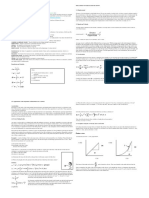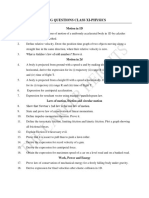4.2.3 Conversions From One Base To Another
Uploaded by
Mahesh Singh4.2.3 Conversions From One Base To Another
Uploaded by
Mahesh Singh4.2.
3 Conversions from one Base to another
It is usual to give data in per unit to its own rating [ex: The manufacturer of a certain piece of equipment, such as a transformer, would not know the exact rating of the power system in which the equipment is to be used. However, he would know the rating of his equipment]. As different components can have different ratings, and different from the system rating, it is necessary to convert all quantities to a common base to do arithmetic or algebraic operations. Additions, subtractions, multiplications and divisions will give meaningful results only if they are to the same base. This can be done for three phase systems as follows.
4.2.4 Per Unit Quantities across Transformers
When a transformer is present in a power system, although the power rating on either side of a transformer remains the same, the voltage rating changes, and so does the base voltage across a transformer. [This is like saying that full or 100% (or 1 pu) voltage on the primary of a 220kV/33 kV transformer corresponds to 220 kV while on the secondary it corresponds to 33 kV.] Since the power rating remains unchanged, the impedance and current ratings also change accordingly. While a common MVA3base can and must be selected for a power system to do analysis, a common VLLbase must be chosen corresponding to a particular location (or side of transformer) and changes in proportion to the nominal voltage ratio whenever a transformer is encountered. Thus the current base changes inversely as the ratio. Hence the impedance base changes as the square of the ratio. For a transformer with turns ratio NP:NS, base quantities change as follows.
4.3 Symmetrical Three Phase Fault Analysis
A three phase fault is a condition where either (a) all three phases of the system are shortcircuited to each other, or (b) all three phase of the system are earthed.
This is in general a balanced condition, and we need to only know the positive-sequence network to analyse faults. Further, the single line diagram can be used, as all three phases carry equal currents displaced by 120o. Typically, only 5% of the initial faults in a power system, are three phase faults with or without earth. Of the unbalanced faults, 80 % are line-earth and 15% are double line faults with or without earth and which can often deteriorate to 3 phase fault. Broken conductor faults account for the rest.
4.3.1 Fault Level Calculations
In a power system, the maximum the fault current (or fault MVA) that can flow into a zero impedance fault is necessary to be known for switch gear solution. This can either be the balanced three phase value or the value at an asymmetrical condition. The Fault Level defines the value for the symmetrical condition. The fault level is usually expressed in MVA (or corresponding per-unit value), with the maximum fault current value being converted using the nominal voltage rating. MVAbase = 3 . Nominal Voltage(kV) . Ibase (kA) MVAFault = 3 . Nominal Voltage(kV) . Isc (kA) where MVAFault - Fault Level at a given point in MVA Ibase Isc - Rated or base line current - Short circuit line current flowing in to a fault
The per unit value of the Fault Level may thus be written as The per unit voltage for nominal value is unity, so that
The Short circuit capacity (SCC) of a busbar is the fault level of the busbar. The strength of a busbar (or the ability to maintain its voltage) is directly proportional to its SCC. An infinitely strong bus (or Infinite bus bar) has an infinite SCC, with a zero equivalent impedance and will maintain its voltage under all conditions. Magnitude of short circuit current is time dependant due to synchronous generators. It is initially at its largest value and decreasing to steady value. These higher fault levels tax Circuit Breakers adversely so that current limiting reactors are sometimes used. The Short circuit MVA is a better indicator of the stress on CBs than the short circuit current as CB has to withstand recovery voltage across breaker following arc interruption. The currents flowing during a fault is determined by the internal emfs of machines in the network, by the impedances of the machines, and by the impedances between the machines and the fault.
4.4 Revision of Symmetrical Component Analysis
Unbalanced three phase systems can be split into three balanced components, namely Positive Sequence (balanced and having the same phase sequence as the unbalanced supply), Negative Sequence (balanced and having the opposite phase sequence to the unbalanced supply) and Zero Sequence (balanced but having the same phase and hence no phase sequence). These are known as the Symmetrical Components or the Sequence Components.
The phase components are the addition of the symmetrical components and can be written as follows.
The unknown unbalanced system has three unknown magnitudes and three unknown angles with respect to the reference direction. Similarly, the combination of the 3 sequence components will also have three unknown magnitudes and three unknown angles with respect to the reference direction. Thus the original unbalanced system effectively has 3 complex unknown quantities a, b and c (magnitude and phase angle of each is independent), and that each of the balanced components have only one independent complex unknown each, as the others can be written by symmetry. Thus the three sets of symmetrical components also have effectively 3 complex unknown quantities. These are usually selected as the components
of the first phase a (i.e. a0, a1 and a2) . One of the other phases could have been selected as well, but all 3 components should be selected for the same phase. Thus it should be possible to convert from either sequence components to phase components or vice versa.
4.4.1 Definition of the operator
When the balanced components occurring angle is 1200. are considered, we see that the most frequently
In complex number theory, we defined j as the complex operator which is equal to -1 and a magnitude of unity, and more importantly, when operated on any complex number rotates it anti-clockwise by an angle of 900. i.e. j = -1 = 1 900
In like manner, we define a new complex operator which has a magnitude of unity and when operated on any complex number rotates it anti-clockwise by an angle of 1200. i.e. = 1 1200 = - 0.500 + j 0.866 Some Properties of 2 3 i.e. = 12/3 or 11200 = 14/3 or 12400 or 1-1200 = 12 3 - 1 or 13600 or 1
= ( - 1)( 2 + + 1) = 0
Since is complex, it cannot be equal to 1, so that - 1 cannot be zero. 2 + + 1 = 0 This also has the physical meaning that the three sides of an equilateral triangles must close
Also 1 = 2
and
2 =
4.4.2 Analysis of decomposition of phasors
Let us again examine the sequence components of the unbalanced quantity, with each of the components written in terms of phase a components, and the operator ,
We can express all the sequence components in terms of the quantities for A phase using the properties of rotation of 00, 1200 or 2400. Thus
This can be written in matrix form. [ ] [ ][ ]
This gives the basic symmetrical component matrix equation, which shows the relationship between the phase component vector Ph and the symmetrical component vector Sy using the symmetrical component matrix []. Both the phase component vector Ph and the symmetrical component vector Sy can be either voltages or currents, but in a particular equation, they must of course all be of the same type. Since the matrix is a [33] matrix, it is possible to invert it and express Sy in terms of Ph.
4.4.3 Decomposition of phasors into symmetrical components
Now let us invert the symmetrical component matrix []. [ ] [ ] [ ]
[ and the discriminant
Substituting, the matrix equation simplifies to give [ ] Since 1
=
2,
and 1 + + 2 = 0, the matrix equation further simplifies to [ ] [ ]
It is seen that is the complex conjugate of 2, and 2 is the complex conjugate of . Thus the above matrix []-1 is one-third of the complex conjugate of []. [ ] This can now be written in the expanded form as [ ] [ ][ ] [ ]
You might also like
- Electrical Fault Calculation - Positive Negative Zero Sequence Impedance100% (1)Electrical Fault Calculation - Positive Negative Zero Sequence Impedance8 pages
- Symmetrical Components & Faults CalculationsNo ratings yetSymmetrical Components & Faults Calculations26 pages
- An Introduction To Symmetrical Components, System Modeling and Fault CalculationNo ratings yetAn Introduction To Symmetrical Components, System Modeling and Fault Calculation66 pages
- Representation of Power Systems: 1.1 One Line Diagram100% (1)Representation of Power Systems: 1.1 One Line Diagram17 pages
- How The Three Phase System Voltages Are Derived With Respect To ABC and CBA SequenceNo ratings yetHow The Three Phase System Voltages Are Derived With Respect To ABC and CBA Sequence13 pages
- Transformations - Dqo, Alpha-Beta and Symmetrical ComponentsNo ratings yetTransformations - Dqo, Alpha-Beta and Symmetrical Components12 pages
- Three-Phase To Two-Phase/One-Phase Conversion Using TWO TRANSFORMERS (Scott Connection)No ratings yetThree-Phase To Two-Phase/One-Phase Conversion Using TWO TRANSFORMERS (Scott Connection)13 pages
- Electrical Fault Calculation Positive Negative Zero Sequence ImpedanceNo ratings yetElectrical Fault Calculation Positive Negative Zero Sequence Impedance7 pages
- Comparing Impact of STATCOM and SSSC On The Performance of Digital Distance RelayNo ratings yetComparing Impact of STATCOM and SSSC On The Performance of Digital Distance Relay7 pages
- One-Line Diagram: Simplified Single-Phase Balanced Three-Phase Single Line Apparatus SymbolsNo ratings yetOne-Line Diagram: Simplified Single-Phase Balanced Three-Phase Single Line Apparatus Symbols25 pages
- Mathematics of Three-Phase Electric PowerNo ratings yetMathematics of Three-Phase Electric Power7 pages
- Representation of Power System ComponentsNo ratings yetRepresentation of Power System Components14 pages
- Determination of Sequence Impedance of A Cylinder Motor Synchronous MachineNo ratings yetDetermination of Sequence Impedance of A Cylinder Motor Synchronous Machine9 pages
- Short Circuit Analysis Objective Type QuestionsNo ratings yetShort Circuit Analysis Objective Type Questions7 pages
- Relay Setting (Directional) : Leakage FluxNo ratings yetRelay Setting (Directional) : Leakage Flux8 pages
- Module 3: Sequence Components and Fault Analysis: Sequence ComponentsNo ratings yetModule 3: Sequence Components and Fault Analysis: Sequence Components11 pages
- Some Power Electronics Case Studies Using Matlab Simpowersystem BlocksetFrom EverandSome Power Electronics Case Studies Using Matlab Simpowersystem BlocksetNo ratings yet
- Simulation of Some Power Electronics Case Studies in Matlab Simpowersystem BlocksetFrom EverandSimulation of Some Power Electronics Case Studies in Matlab Simpowersystem BlocksetNo ratings yet
- Simulation of Some Power Electronics Case Studies in Matlab Simpowersystem BlocksetFrom EverandSimulation of Some Power Electronics Case Studies in Matlab Simpowersystem BlocksetNo ratings yet
- STEM: Science, Technology, Engineering and Maths Principles Teachers Pack V10From EverandSTEM: Science, Technology, Engineering and Maths Principles Teachers Pack V10No ratings yet
- Trifocal Tensor: Exploring Depth, Motion, and Structure in Computer VisionFrom EverandTrifocal Tensor: Exploring Depth, Motion, and Structure in Computer VisionNo ratings yet
- Name of Examination-April-May, 2019: Available DetailsNo ratings yetName of Examination-April-May, 2019: Available Details6 pages
- BE (6 Semester) Examination, Nov.-Dec., 2017: Process ControlNo ratings yetBE (6 Semester) Examination, Nov.-Dec., 2017: Process Control4 pages
- Diploma in Engg. (Third Semester) Examination, April-May 2018No ratings yetDiploma in Engg. (Third Semester) Examination, April-May 20188 pages
- BE (6th Semester) Examination, April-May, 2018: Printed Pages: 3 Roll NoNo ratings yetBE (6th Semester) Examination, April-May, 2018: Printed Pages: 3 Roll No4 pages
- Electrical Power and Energy Systems: S.S. Gokhale, V.S. KaleNo ratings yetElectrical Power and Energy Systems: S.S. Gokhale, V.S. Kale7 pages
- M. Tech. (Second Semester) Examination, April-May 2018No ratings yetM. Tech. (Second Semester) Examination, April-May 20184 pages
- Bharat Sanchar Nigam Limited: Receipt DetailsNo ratings yetBharat Sanchar Nigam Limited: Receipt Details1 page
- Implementation of Problem Based Learning For Sessio1No ratings yetImplementation of Problem Based Learning For Sessio11 page
- Ué Íïré Qéôsrééçmülé Luéç Méëiréérélé MéëuwésNo ratings yetUé Íïré Qéôsrééçmülé Luéç Méëiréérélé Méëuwés1 page
- Shri Guru Harikishan Public School: LudhianaNo ratings yetShri Guru Harikishan Public School: Ludhiana1 page
- Application of Intelligent Optimization Methods For The Design of Excitation Controllers of Power SystemNo ratings yetApplication of Intelligent Optimization Methods For The Design of Excitation Controllers of Power System1 page
- Following Are The Glimpse of The Po'S Andpeo'S Dissemination in Various Places Within The DepartmentNo ratings yetFollowing Are The Glimpse of The Po'S Andpeo'S Dissemination in Various Places Within The Department2 pages
- Modeling of The State Space Vector PWM (SVPWM) Based STATCOM For Voltage Improvement in The Transmission LineNo ratings yetModeling of The State Space Vector PWM (SVPWM) Based STATCOM For Voltage Improvement in The Transmission Line12 pages
- Space Laser Communications: A Review of Major Programs in The United StatesNo ratings yetSpace Laser Communications: A Review of Major Programs in The United States11 pages
- Deleted 31421 - Aritificial Intelligence Cheat SheetNo ratings yetDeleted 31421 - Aritificial Intelligence Cheat Sheet2 pages
- Trigonometric Ratios of Special Angles 2No ratings yetTrigonometric Ratios of Special Angles 21 page
- Decision Trees Classification: Mustafa JarrarNo ratings yetDecision Trees Classification: Mustafa Jarrar46 pages
- Pressure Vessel Plates, Alloy Steel, 9 Percent Nickel, Double-Normalized and TemperedNo ratings yetPressure Vessel Plates, Alloy Steel, 9 Percent Nickel, Double-Normalized and Tempered3 pages
- Bdopsmay14 Slow Moving Whitepaper Proof v3No ratings yetBdopsmay14 Slow Moving Whitepaper Proof v36 pages
- Urbane Junior College: 01. Straight LinesNo ratings yetUrbane Junior College: 01. Straight Lines15 pages
- Electrical Fault Calculation - Positive Negative Zero Sequence ImpedanceElectrical Fault Calculation - Positive Negative Zero Sequence Impedance
- An Introduction To Symmetrical Components, System Modeling and Fault CalculationAn Introduction To Symmetrical Components, System Modeling and Fault Calculation
- Representation of Power Systems: 1.1 One Line DiagramRepresentation of Power Systems: 1.1 One Line Diagram
- How The Three Phase System Voltages Are Derived With Respect To ABC and CBA SequenceHow The Three Phase System Voltages Are Derived With Respect To ABC and CBA Sequence
- Transformations - Dqo, Alpha-Beta and Symmetrical ComponentsTransformations - Dqo, Alpha-Beta and Symmetrical Components
- Three-Phase To Two-Phase/One-Phase Conversion Using TWO TRANSFORMERS (Scott Connection)Three-Phase To Two-Phase/One-Phase Conversion Using TWO TRANSFORMERS (Scott Connection)
- Electrical Fault Calculation Positive Negative Zero Sequence ImpedanceElectrical Fault Calculation Positive Negative Zero Sequence Impedance
- Comparing Impact of STATCOM and SSSC On The Performance of Digital Distance RelayComparing Impact of STATCOM and SSSC On The Performance of Digital Distance Relay
- One-Line Diagram: Simplified Single-Phase Balanced Three-Phase Single Line Apparatus SymbolsOne-Line Diagram: Simplified Single-Phase Balanced Three-Phase Single Line Apparatus Symbols
- Determination of Sequence Impedance of A Cylinder Motor Synchronous MachineDetermination of Sequence Impedance of A Cylinder Motor Synchronous Machine
- Module 3: Sequence Components and Fault Analysis: Sequence ComponentsModule 3: Sequence Components and Fault Analysis: Sequence Components
- Some Power Electronics Case Studies Using Matlab Simpowersystem BlocksetFrom EverandSome Power Electronics Case Studies Using Matlab Simpowersystem Blockset
- Simulation of Some Power Electronics Case Studies in Matlab Simpowersystem BlocksetFrom EverandSimulation of Some Power Electronics Case Studies in Matlab Simpowersystem Blockset
- Simulation of Some Power Electronics Case Studies in Matlab Simpowersystem BlocksetFrom EverandSimulation of Some Power Electronics Case Studies in Matlab Simpowersystem Blockset
- STEM: Science, Technology, Engineering and Maths Principles Teachers Pack V10From EverandSTEM: Science, Technology, Engineering and Maths Principles Teachers Pack V10
- Trifocal Tensor: Exploring Depth, Motion, and Structure in Computer VisionFrom EverandTrifocal Tensor: Exploring Depth, Motion, and Structure in Computer Vision
- Name of Examination-April-May, 2019: Available DetailsName of Examination-April-May, 2019: Available Details
- BE (6 Semester) Examination, Nov.-Dec., 2017: Process ControlBE (6 Semester) Examination, Nov.-Dec., 2017: Process Control
- Diploma in Engg. (Third Semester) Examination, April-May 2018Diploma in Engg. (Third Semester) Examination, April-May 2018
- BE (6th Semester) Examination, April-May, 2018: Printed Pages: 3 Roll NoBE (6th Semester) Examination, April-May, 2018: Printed Pages: 3 Roll No
- Electrical Power and Energy Systems: S.S. Gokhale, V.S. KaleElectrical Power and Energy Systems: S.S. Gokhale, V.S. Kale
- M. Tech. (Second Semester) Examination, April-May 2018M. Tech. (Second Semester) Examination, April-May 2018
- Implementation of Problem Based Learning For Sessio1Implementation of Problem Based Learning For Sessio1
- Application of Intelligent Optimization Methods For The Design of Excitation Controllers of Power SystemApplication of Intelligent Optimization Methods For The Design of Excitation Controllers of Power System
- Following Are The Glimpse of The Po'S Andpeo'S Dissemination in Various Places Within The DepartmentFollowing Are The Glimpse of The Po'S Andpeo'S Dissemination in Various Places Within The Department
- Modeling of The State Space Vector PWM (SVPWM) Based STATCOM For Voltage Improvement in The Transmission LineModeling of The State Space Vector PWM (SVPWM) Based STATCOM For Voltage Improvement in The Transmission Line
- Space Laser Communications: A Review of Major Programs in The United StatesSpace Laser Communications: A Review of Major Programs in The United States
- Deleted 31421 - Aritificial Intelligence Cheat SheetDeleted 31421 - Aritificial Intelligence Cheat Sheet
- Pressure Vessel Plates, Alloy Steel, 9 Percent Nickel, Double-Normalized and TemperedPressure Vessel Plates, Alloy Steel, 9 Percent Nickel, Double-Normalized and Tempered


